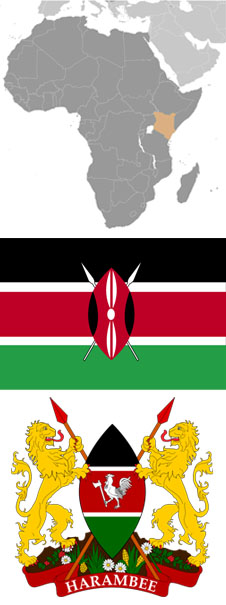Country basics
 Full name:
Full name:
Republic of Kenya (Jamhuri ya Kenya).
Motto:
"Harambee" ("Let us all pull together").
Flag:
Three equal horizontal bands. Black (top) symbolising the majority population, red for the blood shed in the struggle for freedom, and green for the land and natural wealth. The narrower white bands represent peace. A superimposed red, black and white Maasai shield and crossed spears symbolises the defense of freedom.
National anthem:
'Ee Mungu Nguvu Yetu' ('O God of All Creation').
Adopted 1963, based on a traditional Kenyan folk song.
Click here to listen.
National symbol:
Lion.
Independence:
12 December 1963. Formerly it was a colony of the UK since 1920.
Political system:
Parliamentary democracy. Constitution adopted 27 August 2010.
President:
Mwai Kibaki, since 30 December 2002.
Location and borders:
East Africa, bordering the Indian Ocean and Lake Victoria (536 km), Somalia (682 km), Ethiopia (861 km), South Sudan (232 km), Uganda (933 km) and Tanzania (769 km). The Ilemi triangle bordering South Sudan is in dispute and has been administered by Kenya since colonial times.
Geographic coordinates:
1 00 N, 38 00 E
Area:
580,370 km² (224,081 sq miles), 49th in the world, slightly more than twice the size of Nevada.
Administrative divisions:
Seven provinces and one area: Central, Coast, Eastern, Nairobi Area, North Eastern, Nyanza, Rift Valley and Western. The constitution designates 47 counties as local administrative units, but they are still under definition.
Population:
43 million (July 2012).
Capital:
Nairobi, population 3.375 million (2009). Geographic coordinates 1 17 S, 36 49 E.
Second major city:
Mombasa, population 966,000 (2009).
Languages:
English, Kiswahili, indigenous languages.
Religions:
Protestant, Roman Catholic, Muslim, indigenous beliefs.
Currency:
Kenyan Shilling (KSH) = 100 cents.
Internet domain:
.ke
International dialling code:
+254
|



